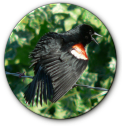Results of the 2011 Statewide Survey
The results of the 2011 Statewide Survey have been released by Audubon California's Keiller Kyle, the survey coordinator.
The results show a dramatic drop in the number of tricolors statewide, from approximately 395,000 in 2008 to about 259,000 this year, a greater than 33% decrease, this despite an increase in the number of sites visited and an immense effort by 100 survey participants.
The results of this year's survey are summarized in a report from Kyle and Rodd Kelsey, the 2008 Statewide Survey coordinator. Their report is available on the Audubon California website (http://ca.audubon.org/birds/tcb-cencus-11.php) and here on the Portal.
We thank the many volunteer observers for their dedication and hard work in helping to monitor the abundance, distribution, and breeding habitats utilized by the tricolor - California's blackbird.
Recent Enhancements to the Portal
Information for the Environment (ICE) staff at the University of California, Davis has recently upgraded the Tricolored Blackbird Portal to facilitate access to data, provide greater data input functionality, and to support the 2011 Statewide Survey and all future statewide surveys.
These enhancements include:
- An improved menu structure that allows easier access to data and facilitates data input
- Structural changes to the underlying database to accommodate data from multiple statewide surveys
- Online help files to provide guidance to new Portal users
- Links to provide data downloads in csv and xls file formats
- A share button that enables users to recommend the Portal to numerous social networking sites
- Improvements to the image gallery that make it easier to add photos and digital imagery
- A link on the Contents Menu to a page for suggestions on where to see tricolors.
2011 Statewide Survey
The 2011 Tricolored Blackbird Statewide Survey has arrived!!!
The 2011 statewide survey runs from Friday, April 15th through Sunday, April 17th.
Participants in the 2011 Statewide Survey should click here (http://tricolor.ice.ucdavis.edu/node/4875) to obtain additional information and to download survey materials.
We are seeking additional participants to survey both historical colony locations as well as to survey in appropriate regions for new, previously undocumented colony locations and to estimate the number of birds at occupied sites. No prior experience is necessary and any level of commitment, big or small, is welcome to help to make this year's survey as complete as possible.
To volunteer for this year's statewide survey, contact Keiller Kyle at kkyle (at) audubon (dot) org.
New Report Documents Decline of Southern California Population Segment
A new report, "Recent History and Current Status of the Tricolored Blackbird in Southern California", prepared by the Western Riverside County Multiple Species Habitat Conservation Plan Biological Monitoring Program, has just been released. The report reviews the annual abundance of breeding tricolors in southern California since 1994 and provides an update on the status of the species.
The report documents the alarming decline of tricolor abundance in southern California since 1997 and reveals the importance of Riverside County to tricolors in the entire southern California region.
The report provides suggestions for management actions that may help to reverse the decline and enhance the prospects for the persistence of the species in southern California.
Cattle egrets decimating tricolors
In 2006, fewer than 30 cattle egrets (Bubulcus ibis) were observed for the first time preying upon the contents of nests of tricolored blackbirds in a single colony in Tulare County. During March and April, 2010, three large (> 30,000 birds each) tricolor colonies in Tulare County suffered near-total productivity losses to predation by cattle egrets, where up to 220 cattle egrets were consistently seen in tricolor colonies.
Thus, in only four years the cattle egret has become perhaps the tricolor's most serious threat to survival, and if the scope of cattle egret predation should increase beyond Tulare County (so recently a population source but now a population sink) , the tricolor could be in serious jeopardy. Cattle egrets are common, and increasing in abundance, throughout much of the Central Valley, but to date they have been documented to prey upon tricolors only in Tulare County.
Nearly 40,000 Tricolors Banded in 4 Years
Tricolored blackbirds are being banded as part of a statewide effort to identify and document movement patterns and fidelity to breeding colonies. The banding of tricolors began in 2007 and has continued annually, with over 39,800 tricolors banded by autumn, 2010. Thus far, all birds have been banded during the breeding season at sites adjacent to breeding colonies.
The recapture of banded birds has demonstrated strong fidelity to breeding sites and a high degree of colony cohesion, with birds breeding together at one location tending to move as a group to breed together again at a different location. Previously-banded birds tend to be recaptured in groups, a phenomenon that requires an explanation while suggesting that birds are not only breeding site faithful, but that breeding birds may recreate spatial relationships established in one location at subsequent breeding colonies.
Help: Report Observations of Color-banded Tricolors
Tricolored blackbirds have been banded in 2007 and 2008. As of August, 2008, a total of just under 7,000 tricolors has been banded. Most of the banded birds (nearly all adults) have received both USGS aluminum bands as well as two color bands, one color indicating year, and the other indicating site of banding. The Tricolored Blackbird Portal now enables you to enter records of observations ("resightings") of color-banded birds.
Resightings of color-banded tricolored blackbirds enable investigators to document spatial and temporal patterns of tricolor movements and we urge you to record your observations of color-banded tricolors here:
Acknowledgments
Support for the development of this website has been provided by the U.S. Fish & Wildlife Service and the National Biological Information Infrastructure.
Collaborators on this website include the Information Center for the Environment (U.C. Davis), U.S. Fish & Wildlife Service, Audubon California, the California Department of Fish & Game, Sustainable Conservation, PRBO Conservation Science, and Ted Beedy.








